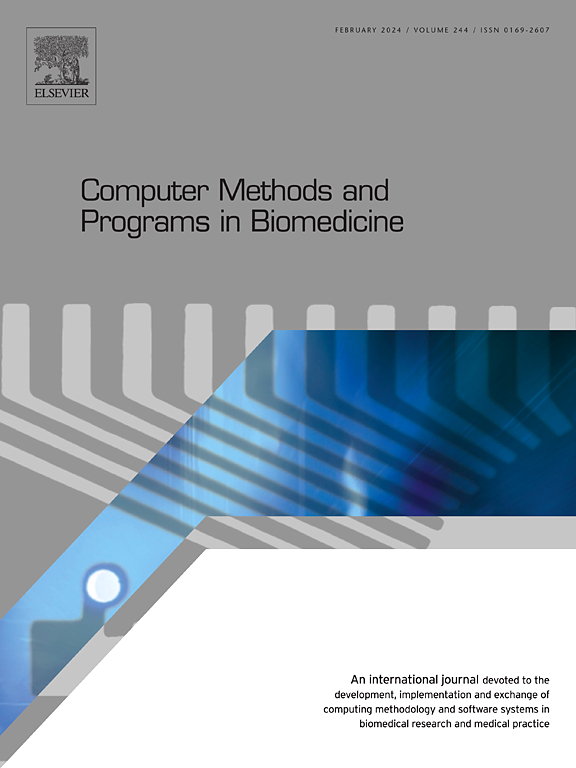A first explainable-AI-based workflow integrating forward-forward and backpropagation-trained networks of label-free multiphoton microscopy images to assess human biopsies of rare neuromuscular disease
IF 4.9
2区 医学
Q1 COMPUTER SCIENCE, INTERDISCIPLINARY APPLICATIONS
引用次数: 0
Abstract
Background and objective
Diagnosis of rare neuromuscular diseases often relies on muscle biopsy analysis, which varies based on the evaluator's experience. Advances in deep learning show promise in improving diagnostic accuracy by identifying standardized features and phenotypic expressions in biopsy images. Explainable artificial intelligence extracts these features from the neural network's “black box,” ensuring compliance with European ethical standards for the use of clinical data in real-world applications. This study proposes a clinic-friendly workflow, based on explainable artificial intelligence. It combines forward-forward and backpropagation-trained convolutional networks to identify complementary features of Duchenne Muscular Dystrophy. Our proposal sets the forward-forward training, applied here for the first time on biomedical images, as a potential new standard for interpretable deep learning applications in clinics.
Methods
We analyzed a multiphoton microscopy dataset of 1600 images from 16 human muscle biopsies obtained during elective spinal surgery, combining autofluorescence, second and third harmonic generation signals. Class Activation Maps unveiled the dual decision-making process of the convolutional network, independently trained with both standard backpropagation and forward-forward algorithms. We evaluated the significance of the discovered features by using the Mann Whitney method. Entire biopsies were analyzed by providing an attention metric, computed as the weighted mean of all significant parameters.
Results
Backpropagation, gold standard for 35 years, and forward-forward achieved over 90 % accuracy in distinguishing healthy and diseased patients tissue. Class activation maps revealed that, when trained independently with both algorithms, the same network identifies Duchenne Muscular Dystrophy tissue by focusing on different features. Both methods identified intramuscular collagen as a key feature. Backpropagation also highlighted collagen waviness and fatty tissue. Forward-forward emphasized collagen density. We integrated these complementary insights, validated by significance analysis, into a standardized attention metric, allowing a multi-structural, quantitative assessment of tissue changes and highlighting areas for further clinical analysis.
Conclusions
Our workflow, using clinically routine biopsies and transparent diagnostic features, demonstrates the unique potential of forward-forward in providing novel, reliable, interpretable results from biomedical images. This paves the way for its dual use with backpropagation, shifting benchmarks by enabling the discovery of features potentially overlooked by backpropagation across biomedical datasets.
求助全文
约1分钟内获得全文
求助全文
来源期刊

Computer methods and programs in biomedicine
工程技术-工程:生物医学
CiteScore
12.30
自引率
6.60%
发文量
601
审稿时长
135 days
期刊介绍:
To encourage the development of formal computing methods, and their application in biomedical research and medical practice, by illustration of fundamental principles in biomedical informatics research; to stimulate basic research into application software design; to report the state of research of biomedical information processing projects; to report new computer methodologies applied in biomedical areas; the eventual distribution of demonstrable software to avoid duplication of effort; to provide a forum for discussion and improvement of existing software; to optimize contact between national organizations and regional user groups by promoting an international exchange of information on formal methods, standards and software in biomedicine.
Computer Methods and Programs in Biomedicine covers computing methodology and software systems derived from computing science for implementation in all aspects of biomedical research and medical practice. It is designed to serve: biochemists; biologists; geneticists; immunologists; neuroscientists; pharmacologists; toxicologists; clinicians; epidemiologists; psychiatrists; psychologists; cardiologists; chemists; (radio)physicists; computer scientists; programmers and systems analysts; biomedical, clinical, electrical and other engineers; teachers of medical informatics and users of educational software.
 求助内容:
求助内容: 应助结果提醒方式:
应助结果提醒方式:


